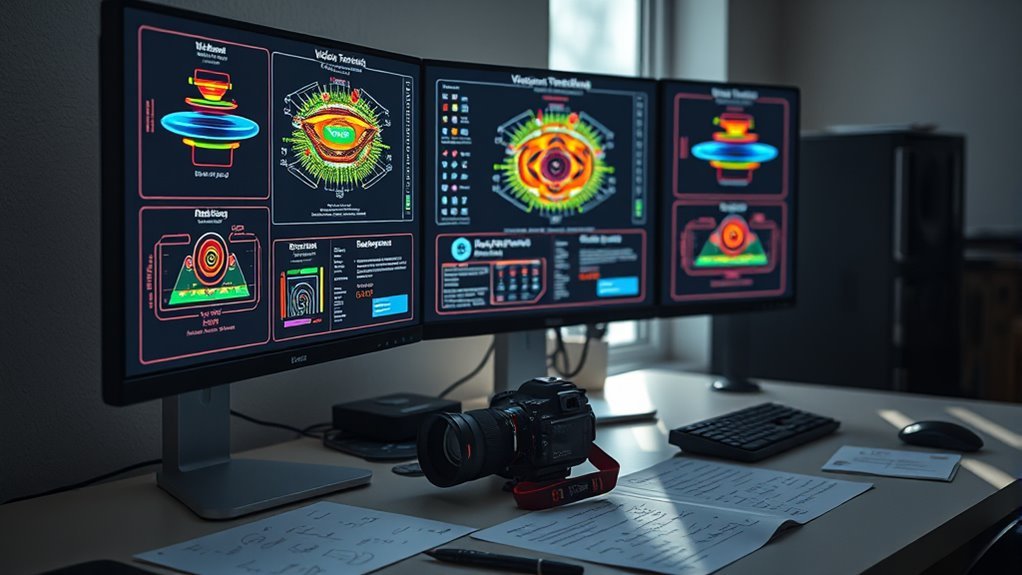To build Vision Transformers (ViTs) for image classification, you’ll convert images into fixed-size patches, embedding each with spatial positional information. You’ll then design deep transformer encoders with multi-head self-attention and feed-forward layers, stabilized by normalization and residual connections. Proper data preprocessing—resizing, normalizing, and augmenting images—is essential for training stability. Optimization involves warm-up learning rates and regularization techniques. Understanding these components helps you create efficient ViTs tailored for robust visual recognition tasks ahead.
Understanding the Vision Transformer Architecture

The Vision Transformer (ViT) architecture adapts the transformer model, originally designed for natural language processing, to handle image data by treating images as sequences of fixed-size patches. You start with image tokenization, splitting the image into patches that become input tokens. Each token passes through layers featuring multi head attention, leveraging the self attention mechanism to capture spatial relationships. Layer normalization and residual connections stabilize training and improve gradient flow. Following attention, feed forward networks process token embeddings independently. This sequence of transformer blocks enables flexible model scaling, allowing you to increase depth or width to enhance performance. Finally, a classification head converts the learned representations into output labels. This modular design empowers you to harness transformers’ strengths in vision tasks while maintaining architectural clarity and extensibility.
Preparing Image Data for Vision Transformers

Preparing image data for Vision Transformers involves several precise steps to confirm compatibility and ideal performance. You start with input resizing, confirming images fit the fixed patch size ViTs require. Next, image normalization scales pixel values to a standard range, improving training stability. Dataset splitting separates your data into training, validation, and test sets, maintaining unbiased evaluation. Label encoding converts categorical labels into numerical formats suitable for classification tasks. Data augmentation expands your dataset variety, enhancing generalization. Finally, batch preparation organizes data into manageable chunks for efficient training.
| Step | Purpose | Key Considerations |
|---|---|---|
| Input Resizing | Confirm fixed patch dimensions | Maintain aspect ratio |
| Image Normalization | Standardize pixel intensity | Use mean and std deviation |
| Data Augmentation | Increase data diversity | Include flips, rotations |
Implementing the Patch Embedding and Positional Encoding

Now that your image data is properly formatted and organized, you’ll focus on converting these images into a format Vision Transformers can process. Start by implementing patch extraction, which divides each image into fixed-size, non-overlapping patches. Each patch is then flattened into a vector and projected linearly, creating patch embeddings. This step permits the model to treat image patches similarly to tokens in natural language processing.
Next, add positional encoding to these patch embeddings to retain spatial information lost during flattening. Positional encoding injects explicit position data, allowing the model to understand the order and relative locations of patches. Commonly, you’ll use learnable positional embeddings added element-wise to the patch embeddings. This combination guarantees the Vision Transformer maintains spatial context essential for accurate image classification.
Leveraging TensorFlow can facilitate efficient implementation and training of these components within Google Cloud’s AI infrastructure.
Designing the Transformer Encoder for Vision Tasks
Although patch embeddings and positional encodings set the stage, you’ll need to design a Transformer encoder that effectively processes these inputs for vision tasks. Start by stacking multiple encoder layers, each comprising a multi-head self attention mechanism followed by position-wise feed-forward networks. The self attention mechanism enables the model to dynamically weigh relationships between image patches, capturing both local and global context. Layer normalization and residual connections are essential to maintain gradient flow and stabilize training. When configuring encoder layers, consider depth and dimensionality based on your task complexity and computational constraints. This modular design grants you the flexibility to tailor the encoder’s capacity while preserving the core inductive biases necessary for image understanding. By carefully architecting these components, your Vision Transformer will harness attention to excel in image classification. Iterative refinement techniques from prompt engineering can inspire improvements in tuning model components for better performance.
Training Strategies and Optimization Tips for ViTs
When training Vision Transformers (ViTs), you’ll need to carefully balance learning rate schedules, batch sizes, and regularization techniques to achieve ideal performance. Start by setting a warm-up phase for the learning rate to stabilize early training iterations. Employ cosine annealing or step decay schedules to adapt the learning rate progressively. Maintain sufficiently large batch sizes to guarantee stable gradient estimates, but adjust based on your hardware constraints. Incorporate strong data augmentation strategies such as random cropping, flipping, and color jitter to improve generalization and prevent overfitting. Regularization methods like dropout and stochastic depth can further enhance robustness. Additionally, apply weight decay to constrain model complexity. Finally, monitor training metrics closely, adjusting hyperparameters iteratively to free yourself from rigid training paradigms and release ViT’s full potential.



